
We are celebrating 15 years — and counting — of stories that are deeply researched and deeply felt, that build a historical record of what the city has been.
We are celebrating 15 years — and counting — of stories that are deeply researched and deeply felt, that build a historical record of what the city has been.
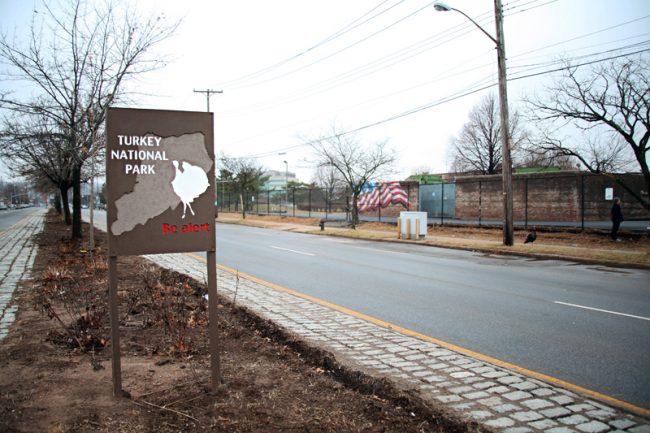
Sign for Staten Island’s Turkey National Park | Photo via Turkey National Park
Whether you are sticking around the city or decamping to greener pastures like a lucky group of Staten Island turkeys, this week we are bringing you plenty of material for your Thanksgiving table conversations. But heed the latest from New York Times’ Standard Editor Philip Corbett: don’t make like the Times and characterize every dish as the new Brooklyn. And if you need to get out and stretch your legs, look no further than SI’s holiday-appropriate Turkey National Park.*
Queens of Affordability
This fall on UO, we brought you the story of two affordable housing developments in Coney Island and a co-op in the South Street Seaport that were built under the State’s Mitchell-Lama program in the 1970s. These developments, subsidized in order to provide stable housing for middle-income families in the midst of another housing crisis, can be found throughout the city. Three years ago Hideki Torpedo, a middle-schooler from one such development — Rochdale Village in Jamaica, Queens — told the true story of his home. Check out his short video below:
Elsewhere in the borough — and across the city — the talk has been of Astoria Cove, a planned development of 1,700 waterfront units just approved by the City Council after negotiations with developer Alma Realty netted 27% of the development for affordable housing. These negotiations once again manifest the de Blasio administration’s commitment to demanding more affordable units from developers, coming on the heels of a similar deal in March for increased affordable units at the Domino Sugar development in Williamsburg. This round, only 2% of the affordable units will be subsidized by the city, and the 400-some to be created will be preserved as affordable in perpetuity. But the subsidization equation that would allow for the market-rate units in the development to cover the costs of the affordable units doesn’t add up, according to some real estate analysts, and Alma’s promise to use only union labor will add additional costs to the project that some consider unviable. Councilmember Laurie Cumbo, who represents Crown Heights, has been urging the administration not to forget about Alma’s planned deregulation of 700 rent-stabilized units in her district. Even with the extra affordable units in Queens, Alma might ultimately bring about a net loss of affordable housing for the city.
The approach seen with Astoria Cove, whereby the City requires unsubsidized affordable units from developers in areas of the city rezoned to allow for denser development, is called mandatory inclusionary zoning, and it is a key tenet of the mayoral administration’s ambitious housing plan. The City’s Economic Development Corporation offers another, untested approach: we’ll give you additional development rights for free in exchange for permanently affordable units. The first rights in question are those of three parcels of undevelopable land under the Queensboro Bridge. A developer could use the rights to build a larger development than zoning currently allows on land within the same area.
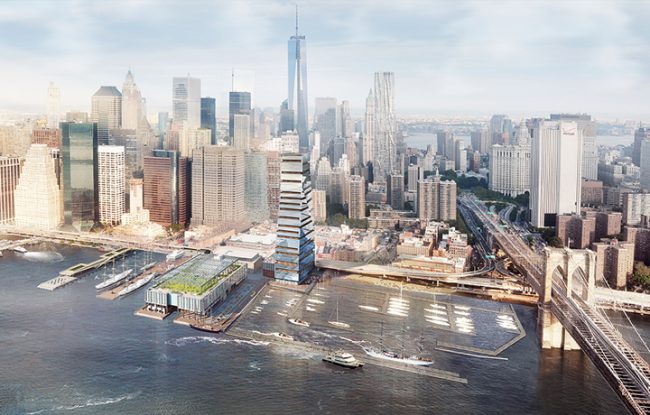
Seaport Tower | Rendering by SHoP Architects
Lapping Against Luxury
Meanwhile, on the banks of the city’s other major river, two new residential towers in the Riverside South mega-project built atop former tracks of the Penn Central Railroad on the far west side of Manhattan are nearing completion. And though the developments will overlook the Hudson, some critics say they are too out of the way for the retail at their bases to thrive, or for a true neighborhood to form in this pocket of glassy towers. Marginality wouldn’t seem to be a problem for a contemplated tower in the South Street Seaport, whose luxury apartments would subsidize public space improvements, among other amenities, in the area. But local councilmember Margaret Chin and Manhattan Borough President Gale Brewer are stalwart in their opposition to the project, despite developer Howard Hughes’ shrinking of the tower by ten stories.
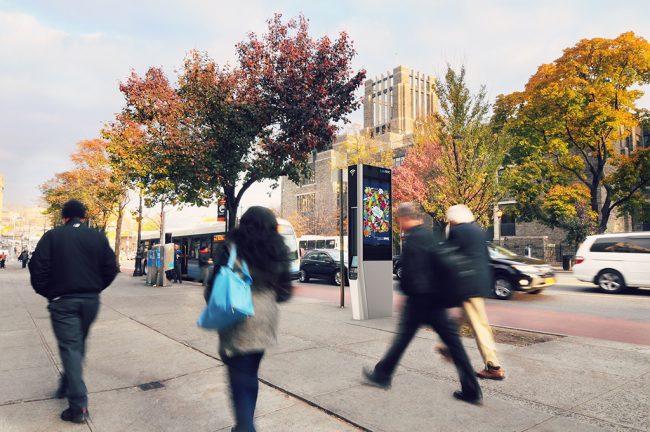
LinkNYC kiosk with ad | Rendering via LinkNYC
Shiny New Things
New Yorkers are now familiar with the piers-turned-parks model, but a new proposal for the Chelsea waterfront would construct anew, rather than repurpose, pier pilings to create a $170 million park/performance space funded primarily by billionaire Barry Diller plus $40 million from the City, State, and the Hudson River Park Trust. And while glowing additions to the public realm are often welcomed, the proposal has drawn concern: the 3,500 capacity main performance space could compete with other proposed Manhattan cultural spaces, and the Thomas Heatherwick design was developed with very little public input.
A project to add some sheen to the public realm, long in the making, was also announced last week: the city’s pay phones will be replaced with so-called LinkNYC kiosks providing free WiFi, cell phone charging, free national calls, and a digital portal to access city services. If fully approved by the City’s Franchise Concession and Review Committee and the Public Design Commission, the first 500 kiosks would hit the streets in 2015 and would grow to an eventual total of 10,000. The kiosks supported by advertising will provide the fastest free WiFi connection in the world, ten times as fast as those without ads, which critics have rightfully noted are predominately located in the city’s lower-income neighborhoods.
Both techie pay phone replacements and an undulating park o’er the river are years away, but fear not: the city can indulge in some new toys this holiday season. The Department of Environmental Protection just christened three new sludge ships into its marine division. The ships, specially designed to handle the tight quarters of Newtown Creek and pesky currents that give part of the East River the endearing name of Hell Gate, transport the byproduct of city sewage to our wastewater management plants for processing. Who’s up for a Thanksgiving cruise?
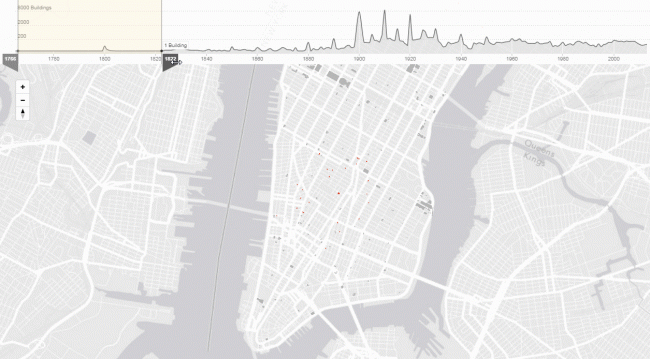
Click the image to launch of an animation of Urban Layers | Animation via Morphocode
Manhattan’s Buildings Look Their Age
Architecture and design firm Morphocode is the source for the hot new urbanist visualization toy: with Urban Layers you can easily check out the approximate age of every building in Manhattan. And for you mapping fiends, read up on the nitty-gritty behind creating the tool.
Bioswales + Industry
The city is about to get a little more absorbent. The Department of Environmental Protection recently announced that it will install 2,000 additional bioswales — curbside gardens that capture and clean stormwater — throughout Brooklyn, Queens, and the Bronx with the aim of tamping down pollution in our waterways. Approximately 200 million gallons of water per year won’t be contributing to overflows of the sewage system any longer! Learn more about bioswales in our 2013 conversation with Paul Mankiewicz.
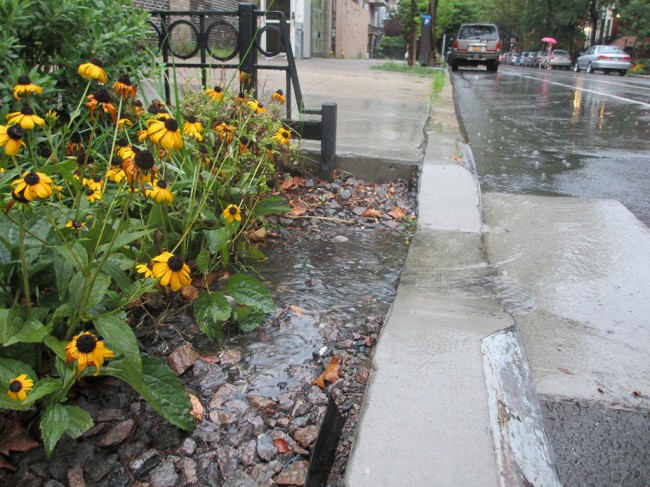
A bioswale on Dean Street in Brooklyn | Photo via NYC Water
One area to benefit will be Gowanus, a primarily industrial neighborhood which, despite the Superfund-designated canal at its heart, has seen an increase in residential development in recent years. Acknowledging that more condos are somewhat inevitable, the area’s elected officials released a development framework that seeks to leverage the increase in land value that could be created by a rezoning allowing denser development to finance infrastructural upgrades, affordable housing, and industry protections in the area. The proposal comes on the heels of the City Council’s release of a plan to create three new zoning districts with the aim of growing the city’s manufacturing sector. The zones would protect existing industrial zones, which the De Blasio administration has targeted as potential sites of workforce housing, and foster mixed-use neighborhoods that incorporate “creative industries” and light manufacturing.
The Beauty of Water Infrastructure
A major goal of Urban Omnibus has always been to make visible the hidden processes, histories, and infrastructures that undergird how our city functions. A new episode in the PBS web series Unusual Spaces takes us to DC for the exploration of a sand filtration water purification facility that cleaned the capital’s water supply from 1905 to 1985. If this only whets your appetite for engineering delights, sink your teeth into Steve Duncan’s photographs of water systems worldwide and Stanley Greenberg’s inside looks at projects under construction.
*Turkey National Park is a lovely, quaint, and fictional park in Staten Island. Keep that in mind when making your holiday plans.
The Roundup keeps you up to date with topics we’ve featured and other things we think are worth knowing about. Formerly a weekly tradition published every Friday, we now bring you the roundup on an occasional basis.
The views expressed here are those of the authors only and do not reflect the position of The Architectural League of New York.
Comments